实验2 现代C++编程初体验
实验任务1
源码
T.cpp
1 #include "T.h" 2 #include <iostream> 3 #include <string> 4 5 // 类T实现 6 7 // static成员数据类外初始化 8 const std::string T::doc{"a simple class sample"}; 9 const int T::max_cnt = 999; 10 int T::cnt = 0; 11 12 // 类方法 13 int T::get_cnt() { 14 return cnt; 15 } 16 17 // 对象方法 18 T::T(int x, int y): m1{x}, m2{y} { 19 ++cnt; 20 std::cout << "T constructor called.\n"; 21 } 22 23 T::T(const T &t): m1{t.m1}, m2{t.m2} { 24 ++cnt; 25 std::cout << "T copy constructor called.\n"; 26 } 27 28 T::T(T &&t): m1{t.m1}, m2{t.m2} { 29 ++cnt; 30 std::cout << "T move constructor called.\n"; 31 } 32 33 T::~T() { 34 --cnt; 35 std::cout << "T destructor called.\n"; 36 } 37 38 void T::adjust(int ratio) { 39 m1 *= ratio; 40 m2 *= ratio; 41 } 42 43 void T::display() const { 44 std::cout << "(" << m1 << ", " << m2 << ")" ; 45 } 46 47 // 普通函数实现 48 void func() { 49 T t5(42); 50 t5.m2 = 2049; 51 std::cout << "t5 = "; t5.display(); std::cout << '\n'; 52 }
T.h
1 #pragma once 2 #include <string> 3 4 class T { 5 public: 6 T(int x = 0, int y = 0); // 普通构造函数 7 T(const T &t); // 拷贝构造函数 8 T(T &&t); // 移动构造函数 9 ~T(); // 析构函数 10 11 void adjust(int ratio); // 按比例调整 12 void display() const; // 输出对象信息 13 14 private: 15 int m1, m2; 16 17 public: 18 static int get_cnt(); // 获取对象总数 19 static const std::string doc; 20 static const int max_cnt; 21 22 private: 23 static int cnt; 24 25 friend void func(); // 友元函数 26 }; 27 28 void func();
task.cpp
1 #include "T.h" 2 #include <iostream> 3 4 void test_T(); 5 6 int main() { 7 std::cout << "test Class T:\n"; 8 test_T(); 9 10 std::cout << "\ntest friend func:\n"; 11 func(); 12 } 13 14 void test_T() { 15 using std::cout; 16 using std::endl; 17 18 cout << "T info: " << T::doc << endl; 19 cout << "T objects'max count: " << T::max_cnt << endl; 20 cout << "T objects'current count: " << T::get_cnt() << endl << endl; 21 22 T t1; 23 cout << "t1 = "; t1.display(); cout << endl; 24 25 T t2(3, 4); 26 cout << "t2 = "; t2.display(); cout << endl; 27 28 T t3(t2); 29 t3.adjust(2); 30 cout << "t3 = "; t3.display(); cout << endl; 31 32 T t4(std::move(t2)); 33 cout << "t4 = "; t4.display(); cout << endl; 34 35 cout << "test: T objects'current count: " << T::get_cnt() << endl; 36 }
运行测试结果截图:
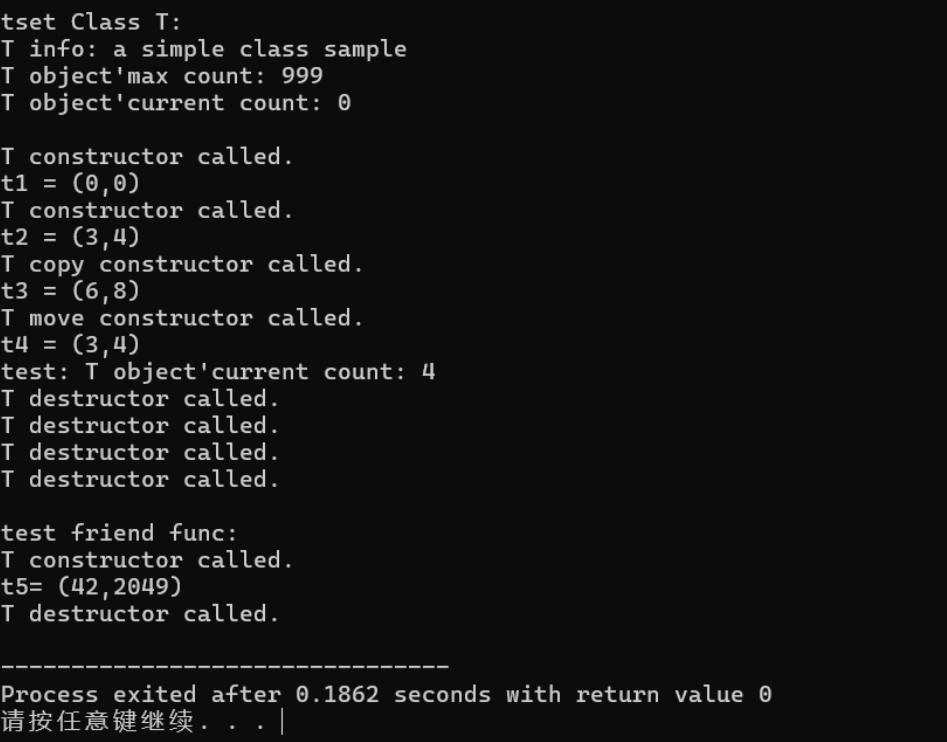
问题1:
T.h中,在类T内部,已声明func 是T的友元函数。在类外部,去掉line36,重新编译,程序能否正常运行?如果能,回答YES;如果不能,以截图形式提供编译报错信息,说明原因。
答:去掉友元声明后,编译错误。func()无法访问类的私有成员m2.

问题2:
T.h中,line9-12给出了各种构造函数、析构函数。总结它们各自的功能、调用时机。
答:
构造函数与析构函数的作用与调用时机:
普通构造:创建对象时;
拷贝构造:以对象初始化对象;
移动构造:右值或临时对象转移;
析构:生命周期结束时。
问题3:
T.cpp中,line13-15,剪切到T.h的末尾,重新编译,程序能否正确编译。
如不能,以截图形式给出报错信息,分析原因。
答:静态成员初始化语句应位于.cpp文件中第8–10行(非13–15)。
若放入.h文件会造成重复定义错误。
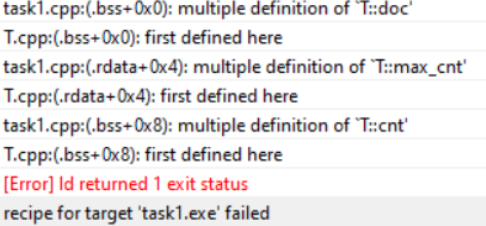
实验任务2
源码:
Complex.h
1 #pragma once 2 #include <string> 3 #include <cmath> 4 5 class Complex { 6 public: 7 Complex(double r = 0.0, double i = 0.0); 8 Complex(const Complex &c); 9 10 double get_real() const; 11 double get_imag() const; 12 void add(const Complex &c); 13 14 static const std::string doc; 15 16 private: 17 double real, imag; 18 friend void output(const Complex &c); 19 friend double abs(const Complex &c); 20 friend Complex add(const Complex &a, const Complex &b); 21 friend bool is_equal(const Complex &a, const Complex &b); 22 friend bool is_not_equal(const Complex &a, const Complex &b); 23 };
Complex.cpp
1 #include "Complex.h" 2 #include <iostream> 3 4 const std::string Complex::doc = "a simplified complex class"; 5 6 Complex::Complex(double r, double i): real{r}, imag{i} {} 7 Complex::Complex(const Complex &c): real{c.real}, imag{c.imag} {} 8 9 double Complex::get_real() const { return real; } 10 double Complex::get_imag() const { return imag; } 11 12 void Complex::add(const Complex &c) { 13 real += c.real; 14 imag += c.imag; 15 } 16 17 void output(const Complex &c) { 18 std::cout << c.real << (c.imag >= 0 ? " + " : " - ") 19 << std::abs(c.imag) << "i"; 20 } 21 22 double abs(const Complex &c) { 23 return std::sqrt(c.real * c.real + c.imag * c.imag); 24 } 25 26 Complex add(const Complex &a, const Complex &b) { 27 return Complex(a.real + b.real, a.imag + b.imag); 28 } 29 30 bool is_equal(const Complex &a, const Complex &b) { 31 return a.real == b.real && a.imag == b.imag; 32 } 33 34 bool is_not_equal(const Complex &a, const Complex &b) { 35 return !(is_equal(a, b)); 36 }
运行测试结果截图:
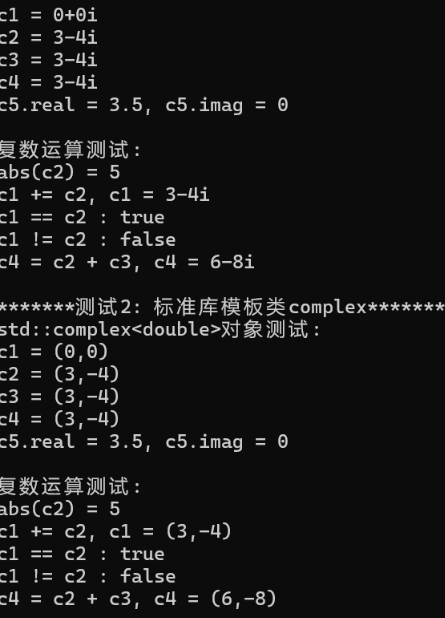
问题1:
比较自定义类complex 和标准库模板类complex的用法,
complex 的用法,在使用形式上,哪一种更简洁?函数和运算内
在有关联吗?
答:标准库的std::complex更简洁,因为它使用了运算符重载,而自定义类通过函数实现。
问题2:
2-1:自定义complex中 的用法,output/abs/add/ 等均设为友元,它们真的需要访问私有数据吗?
答:output/add等函数确实需要访问私有数据,因此设置为friend。
2-2:标准库std::complex 是否把 abs 设为友元?
答:标准库abs不是友元,而是独立函数。
2-3:什么时候才考虑使用 friend?总结你的思考。
答:只有当外部函数确实需要访问私有数据时,才使用friend,避免破坏封装性。
问题3:
如果构造对象时禁用=形式,即遇到complex c4 = c2;编译报错,类complex的设计应如何调整?
答:将 Complex 类的拷贝构造函数声明为 explicit。
实验任务3
源码:
1 #include"PlayerControl.h" 2 #include<iostream> 3 void test() 4 { 5 PlayerControl controller; 6 std::string control_str; 7 std::cout<<"Enter Control: (play/pause/next/prev/stop/quit):\n"; 8 while(std::cin>>control_str) 9 { 10 if(control_str=="quit") 11 break; 12 13 ControlType cmd=controller.parase(control_str); 14 controller.execute(cmd); 15 std::cout<<"Current Player control: "<<PlayerControl::get_cnt()<<"\n\n"; 16 } 17 } 18 int main() 19 { 20 test(); 21 }
运行测试结果截图:
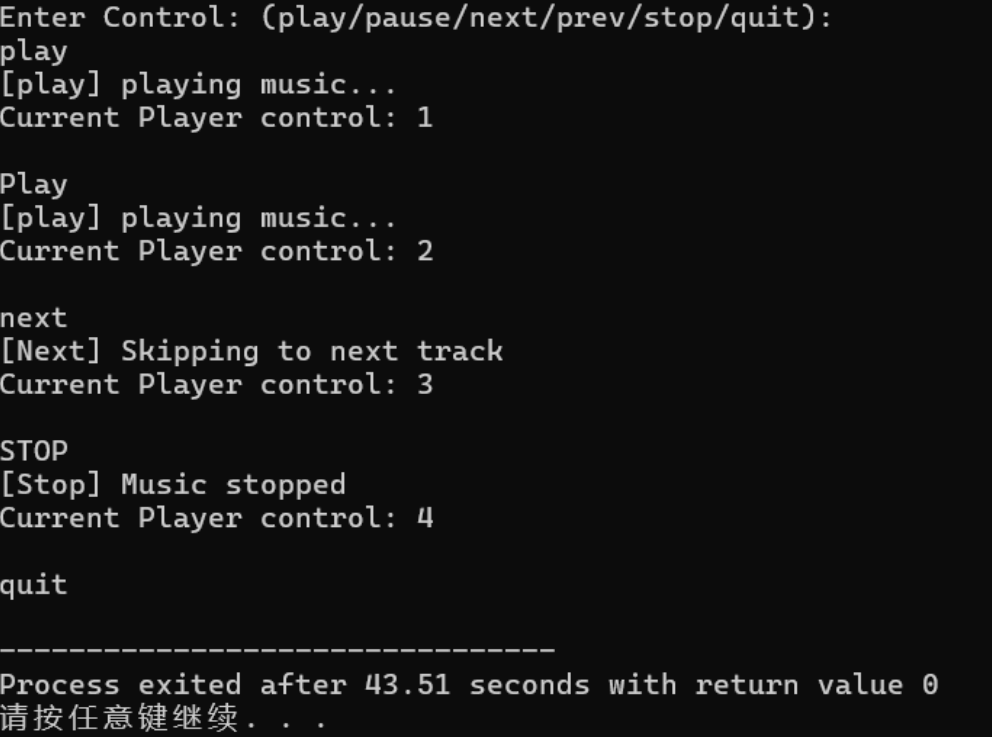
实验任务4
源码:
1 #pragma once 2 #include <string> 3 4 class Fraction { 5 public: 6 Fraction(int up = 0, int down = 1); 7 Fraction(const Fraction& f); 8 9 int get_up() const; 10 int get_down() const; 11 Fraction negative() const; 12 13 static const std::string doc; 14 15 private: 16 int up, down; 17 void simplify(); 18 19 friend void output(const Fraction& f); 20 friend Fraction add(const Fraction& a, const Fraction& b); 21 friend Fraction sub(const Fraction& a, const Fraction& b); 22 friend Fraction mul(const Fraction& a, const Fraction& b); 23 friend Fraction div(const Fraction& a, const Fraction& b); 24 };
1 #include "Fraction.h" 2 #include <iostream> 3 #include <numeric> 4 #include <stdexcept> 5 6 const std::string Fraction::doc = "Fraction类 v0.01版"; 7 8 Fraction::Fraction(int u, int d): up{u}, down{d} { 9 if (down == 0) throw std::invalid_argument("Denominator cannot be zero"); 10 simplify(); 11 } 12 13 Fraction::Fraction(const Fraction& f): up{f.up}, down{f.down} {} 14 15 void Fraction::simplify() { 16 if (down < 0) { down = -down; up = -up; } 17 int g = std::gcd(up, down); 18 if (g != 0) { up /= g; down /= g; } 19 } 20 21 int Fraction::get_up() const { return up; } 22 int Fraction::get_down() const { return down; } 23 24 Fraction Fraction::negative() const { 25 return Fraction(-up, down); 26 } 27 28 void output(const Fraction& f) { 29 std::cout << f.up << "/" << f.down; 30 } 31 32 Fraction add(const Fraction& a, const Fraction& b) { 33 return Fraction(a.up * b.down + b.up * a.down, a.down * b.down); 34 } 35 36 Fraction sub(const Fraction& a, const Fraction& b) { 37 return Fraction(a.up * b.down - b.up * a.down, a.down * b.down); 38 } 39 40 Fraction mul(const Fraction& a, const Fraction& b) { 41 return Fraction(a.up * b.up, a.down * b.down); 42 } 43 44 Fraction div(const Fraction& a, const Fraction& b) { 45 if (b.up == 0) throw std::invalid_argument("Division by zero"); 46 return Fraction(a.up * b.down, a.down * b.up); 47 }
运行测试结果截图:
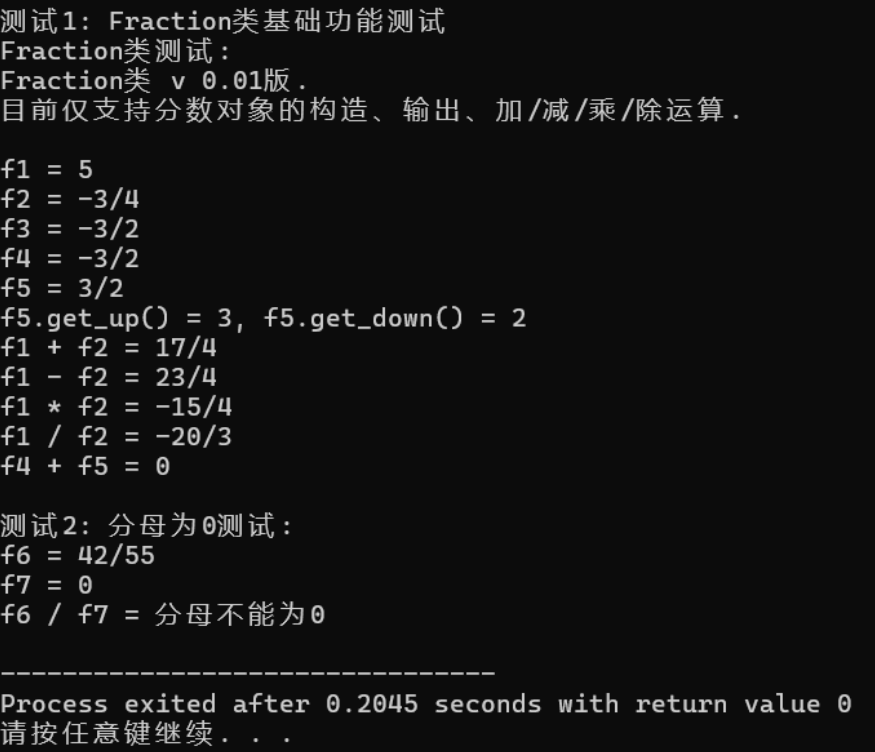
问题:分数的输出和计算,output/add/sub/mul/div ,你选择的是哪一种设计方案?(友元/自由函数/命名空间+自由函数/类+static)
你的决策理由?如友元方案的优缺点、静态成员函数方案的适用场景、命名空间方案的考虑因素等。
答:采用友元函数方案实现 output/add/sub/mul/div。
理由:它们需要访问分子分母的私有成员,友元方式简洁直观。
若仅作读操作,亦可使用命名空间自由函数,但友元更贴合此场景。



 浙公网安备 33010602011771号
浙公网安备 33010602011771号